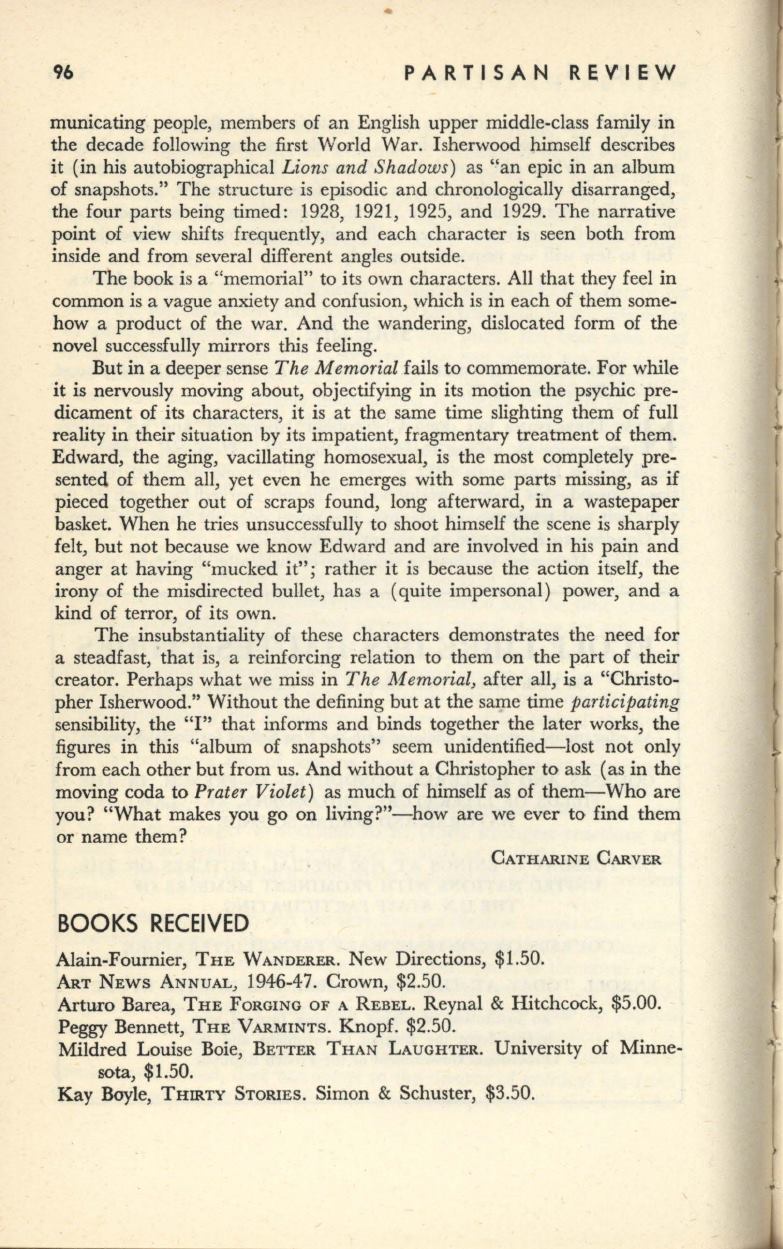
96
PARTISAN REVIEW
municating people, members of an English upper middle-class family in
the decade following the first World War. Isherwood himself describes
it (in his autobiographical
Lions and Shadows)
as "an epic in an album
of snapshots." The structure is episodic and chronologically disarranged,
the four parts being timed: 1928, 1921, 1925, and 1929. The narrative
point of view shifts frequently, and each character is seen both from
inside and from several different angles outside.
The book is a "memorial" to its own characters. All that they feel in
common is a vague anxiety and confusion, which is in each of them some–
how a product of the war. And the wandering, dislocated form of the
novel successfully mirrors this feeling.
But in a deeper sense
The Memorial
fails to commemorate. For while
it is nervously moving about, objectifying in its motion the psychic pre–
dicament of its characters, it is at the same time slighting them of full
reality in their situation by its impatient, fragmentary treatment of them.
Edward, the aging, vacillating homosexual, is the most completely pre–
sented of them all, yet even he emerges with some parts missing, as if
pieced together out of scraps found, long afterward, in a wastepaper
basket. When he tries unsuccessfully to shoot himself the scene is sharply
felt, but not because we know Edward and are involved in his pain and
anger at having "mucked it"; rather it is because the action itself, the
irony of the misdirected bullet, has a (quite impersonal) power, and a
kind of terror, of its own.
The insubstantiality of these characters demonstrates the need for
a steadfast, that is, a reinforcing relation to them on the part of their
creator. Perhaps what we miss in
The A1emorial,
after all, is a "Christo–
pher Isherwood." Without the defining but at the same time
participating
sensibility, the "I" that informs and binds together the later works, the
figures in this "album of snapshots" seem unidentified-lost not only
from each other but from us. And without a Christopher to ask (as in the
moving coda to
Prater Violet)
as much of himself as of them-Who are
you? "What makes you go on living?"-how are we ever to find them
or name them?
CATHARINE CARVER
BOOKS RECEIVED
Alain-Fournier, THE WANDERER. New Directions, $1.50.
ART NEWS ANNUAL, 1946-47. Crown, $2.50.
Arturo Barea, THE FoRGING
OF
A REBEL. Reyna!
&
Hitchcock, $5.00.
Peggy Bennett, THE VARMINTS. Knopf. $2.50.
Mildred Louise Boie, BETTER THAN LAUGHTER. University of Minne-
"I
sota, $1.50.
Kay Boyle, THIRTY SToRIES. Simon
&
Schuster, $3.50.


